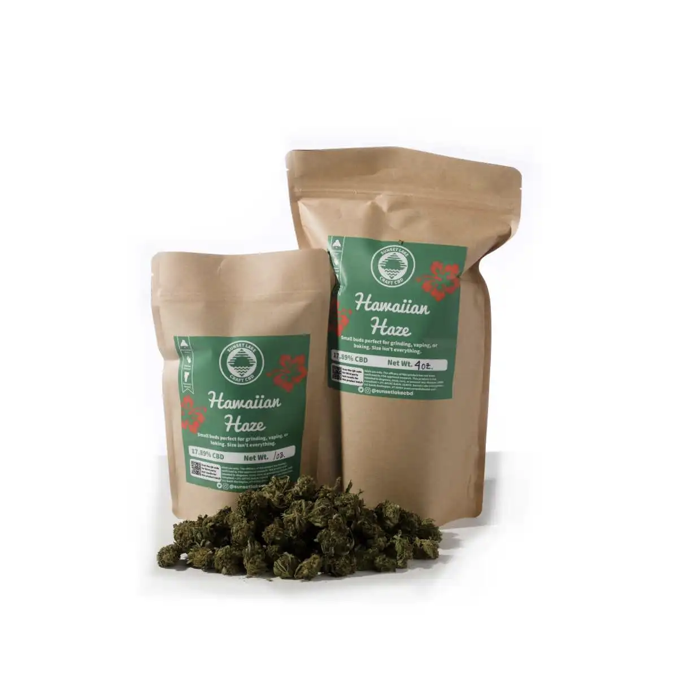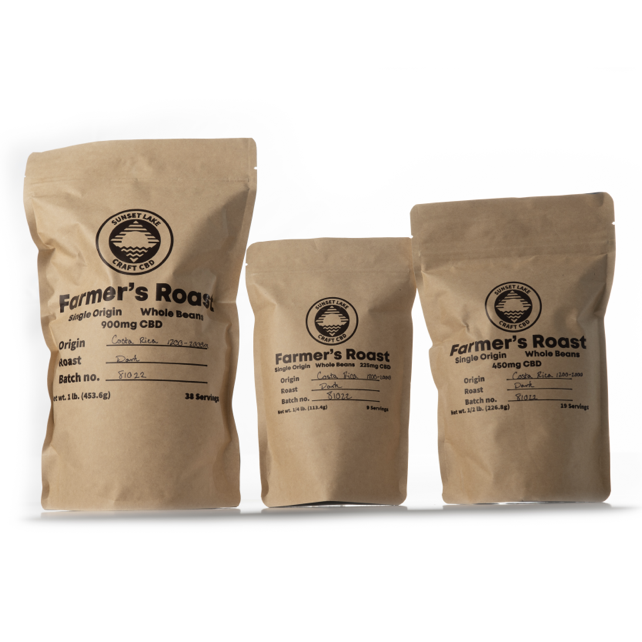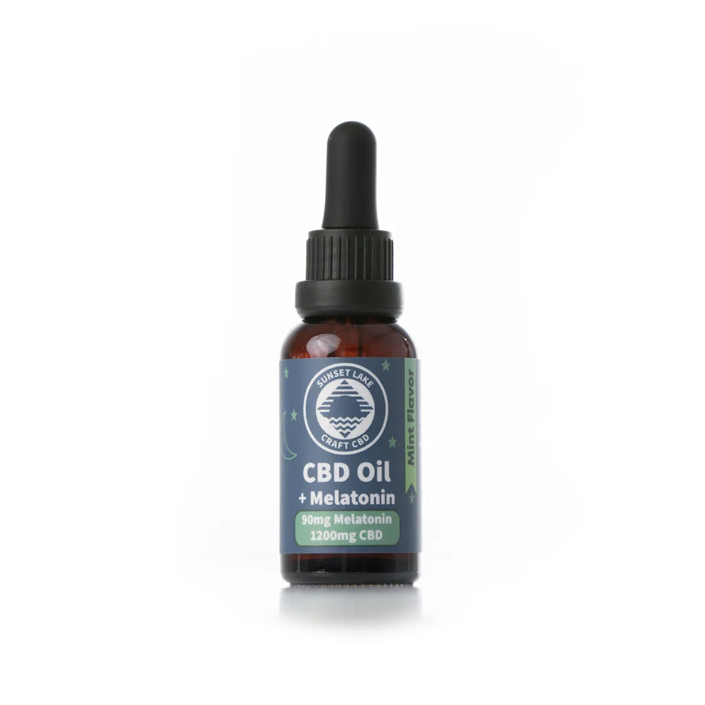By: Kathryn B.
If you find yourself spending more time at home these days, baking hemp edibles infused with CBD could be a great way to reap the benefits of both stress-baking and CBD.
Though CBD is not widely FDA-approved, there is anecdotal evidence that suggests CBD can help with a host of issues including,
These, along with the psychological benefits of creating in the kitchen, are the perfect combination for calm during quarantine.
Hemp Edibles: Why Use CBD Flower?
Although it is possible to use one of Sunset Lake’s CBD oil tinctures, this post will explain how to make hemp edibles using raw CBD hemp flower. Baking with CBD hemp flower is a bit more time-consuming, but offers a more affordable route and is a more interactive and rewarding experience.
Our quick guide to hemp edibles will take you through four steps:
Step 1: Dosing Your Hemp Edibles
There are several online tools that can help you dose your hemp edibles correctly. One of our favorites from the folks over at Veriheal.com is this free-to-use edible dosage calculator.
You’ll need a few things to use this calculator, like:
- A kitchen scale
- The certificate of analysis that corresponds with your hemp flower
- A conversion calculator
Luckily, Sunset Lake CBD’s hemp flower is potent, meaning that we only need a small amount to make a baking oil that has a high CBD concentration.
For the remainder of this piece, let’s refer to Sunset Lake’s 2022 Cherry Abacus strain. You can find the flower here, and its certificate of analysis here. Each certificate of analysis lists a cannabinoid summary, which, for our Cherry Abacus hemp flower, looks like this:
2019 Cherry Abacus Flower Cannabinoid Summary

Our free-to-use calculator does have some limitations we’ll talk about in just a second, but above are the numbers from our Cherry Abacus hemp flower that we’ll want to plug into our calculator.
- Total THC – 0.71%
- Total CBD – 18.82%
Unfortunately, our CBD edible dosage calculator is limited by its ability to calculate whole integers. For the sake of calculating your dosages, round up to the nearest whole number. Trust us, you’d rather have slightly weaker edibles and eat more than be surprised by stronger edibles. After you eat one, there is no going back.
Now we have to make a few assumptions like,
- How much oil we’re infusing
- And, how much flower (in grams) we’re using to infuse
Dosing Our Hemp Edibles
Let’s assume that we’re infusing two cups of butter as that’s the amount that comes in a standard box of four sticks of butter. Let’s also assume that we’re using a full ounce (28 grams) of Cherry Abacus hemp flower.
Using our potency numbers above, and assuming a perfect infusion we find that two cups of infused butter will contain:
- 280 mg of THC
- 5320 mg of CBD
- 2.92 mg of THC per teaspoon
- 55.42 mg of CBD per teaspoon
Those numbers are pretty eye-popping, so we’ll want to make sure that we pick the right recipe. Luckily at the bottom of our hemp edibles calculator, there is a place to enter the number of teaspoons of butter your recipe calls for and the number of servings your recipe will make.
This is where our conversion calculator comes in handy. Let’s assume we’re using half a cup (24 teaspoons) of our infused butter to make cookies. In order to hit our sweet spot of around 25 mg of CBD, we’ll need to make 50 cookies— they’ll be pretty small. Alternatively, we can cut our infused butter with non-infused butter in order to cut the potency.
Dosing Your Hemp Edibles
Dosing your hemp edibles will look a lot like the work we just did in the previous section, but without all of the assumptions. To dial in your preferred dosage, feel free to adjust the amount of flower that you use using your kitchen scale, the amount of butter/oil/fat, and your recipe.
If You Want To Increase The Potency of Your Hemp Edibles
In the example above we used just CBD hemp flower for our infusion. You can also use CBD kief, to compliment your flower in order to give your hemp edibles a little extra kick.
Learn more about Kief, the solventless CBD concentrate here.
Step 2: “Decarb” Your Hemp For Infusion
To decarb your hemp flower for infusion, you’ll need a few things:
- Your raw hemp flower
- Cookie baking sheet or roasting pan
- Aluminum foil
- An oven preheated to 220 degrees F
- An overhead fan, or fan pointing out of an open window
First, cover your baking sheet or roasting pan with aluminum foil. This will help make cleanup easier later and protect your kitchenware in the long run.
Layout your hemp flower on the cookie sheet. You can grind it up or break up the larger buds in order to create more surface area. If you are using a kief concentrate, sprinkle it on top of the buds on the pan, keeping in mind that the kief will make the batch more potent. If you’re using a roasting pan as opposed to a cookie sheet, you can also cover the pan with another layer of foil to keep the hemp smell to a minimum.
Place the cookie sheet in your preheated oven for 45-60 minutes. When your flower is done decarbing, it will have turned a brownish color. There are many different opinions on what works best for decarbing— some recommend leaving the hemp in the oven for 90 minutes to two hours at varying temperatures. Feel free to experiment, but make sure the temperature is never higher than 300F so as not to damage the CBD.
Be aware that decarbing hemp flower is an aromatic process. Make sure your cohabitants are cool with having the entire house smell of cannabis before you place any hemp in the oven.
Can You Decarb Kief?
You can decarb kief just as you would hemp flower. If you plan on decarbing kief by itself, we would recommend pouring your kief into a glass bowl or square pan instead of laying it out on a baking sheet. Kief can be very sticky, but keeping it together will make it more manageable.
Be aware that hemp edibles made purely with CBD kief will have a very strong taste and be quite potent.
Step 3: Infuse Your Fat or Oil for Hemp Edibles
You can use any type of oil that you prefer, whether it’s coconut oil, butter, Crisco, olive oil, etc. Mix in your decarbed hemp and heat your oil at a low heat (about 200 degrees F) on the stove or in a crockpot for four hours. Make sure to stir occasionally. Some people recommend heating your fat or oil for only an hour, others say to leave it for up to eight hours. Again, you can experiment with what you think works best for you and your schedule.
When your decarboxylated flower is done steeping in your oil or fat, strain out the flower. A regular kitchen colander is usually sufficient. If you used kief or finely ground hemp, a cheesecloth or nut milk bag might be needed to separate your flower from the oil.
When your infused oil is cooled, store whatever you are not going to use immediately in an airtight container and place it in either the refrigerator or the freezer.
Infusing Decarbed Flower in a Mason Jar
You can also infuse your fat or oil in a sealed Mason Jar. This is a good option for folks who only want to infuse a small amount at a time or are worried about the smell during infusion.
Add your oil or fat to a mason jar and add your decarbed hemp flower. Screw on your top, but not too tightly, and place the jar in a pot of water over a low burner. Slowly, your fat or oil should melt (if it started as solid,) and over the course of a few hours should take on a dark green appearance.
As you would with any infusion when you’re oil or fat is finished steeping, you’ll want to strain all of the flower out with a colander or cheesecloth. Then, your mason jar-infused oil is ready to go.
Step 4: Time to Bake Your Hemp Edibles!
Now that you have your infused oil, it’s time to get cooking! The only important recommendation here is that you bake or cook your hemp edibles at a temperature no higher than 350F in order to prevent the CBD from boiling off. Otherwise, get creative! Cook from scratch or use a boxed mix from the store!
When you’re ready to eat your hemp edibles, remember: Start low, go slow! Even though we calculated the dosage, there is no way to know the exact dosage of CBD and THC in our hemp edibles without submitting our infused oil for laboratory testing.
Everyone responds differently to CBD and THC, so make sure to eat only a small amount in order to see how your edibles affect you. If you’re a novice to hemp edibles, treat your final product as if it was a THC edible. Do not eat your hemp edibles before operating a vehicle, working, or engaging in any activity that requires full sobriety.
Commonly Asked Questions About Hemp Edibles
How Long Does It Take For Hemp Edibles to Kick In?
Because it takes time for the body to process hemp edibles, it can take up to two hours before feeling any effects. If you think you might be tempted to eat more during that time, consider baking a CBD-free batch of goodies to nibble on in unrestricted amounts while you are waiting for your hemp edibles to kick in.
Once you know how your body reacts to your hemp edibles, you can use them accordingly. After practice and experience, a homemade CBD cookie might become your preferred tasty alternative to tincture or a CBD preroll, whether during the day or when it is time to wind down.
How Long Does Edible Hemp Stay In Your System?
Edible hemp will only last a few hours, but the trace amounts of THC present in your hemp edible may linger in your body for a few weeks. It may even cause you to test positive in a traditional workplace urine test.
Read more about CBD and drug testing here.
Do Hemp Edibles Have Any Side Effects?
Hemp edibles don’t have any exclusive side effects. However, consuming too much CBD can cause you to have an adverse reaction like,
- Dry Mouth
- Diarrhea
- Fatigue
To avoid having an adverse reaction to your hemp edibles, dose them appropriately, and don’t eat more than one at a time.
Time to Make Your Own Hemp Edibles
While you’re here, check out Sunset Lake CBD’s selection of CBD hemp flower and small buds. Small buds are perfect for bakers and chefs alike who are thinking about making their own hemp edibles.
Updated March 31, 2022














